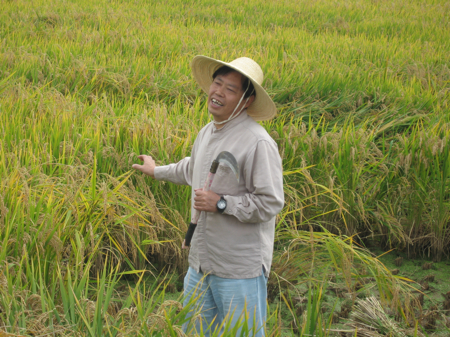
That’s another one to tick off the life list. Above you see Zhu Youyong, who describes himself as a farmer. He happens also to be Distinguished Professor Zhu, President of Yunnan Agricultural College and a hero of mine.
Zhu’s name is associated with a method of growing rice that delivers higher, more stable yields with lower inputs of fungicides and a more stable harvest from year to year. Not bad for an amazingly simple idea. The problem is that traditional landraces of sticky rice, which farmers like to grow and to eat, are susceptible to fungal disease. They also have a nasty tendency to fall over, or lodge, especially when they are carrying a bountiful load of seed. Modern hybrids are disease resistant, and high-yielding, but the taste is not much to write home about. Yields are high, but prices are low. To grow the tasty traditional landraces, farmers need to be able to afford fungicides and they need to be able to overcome their tendency to lodge.
The solution is to grow the varieties as a mixture. In the paddy, four or eight rows of modern hybrid alternate with a row of traditional landrace. The landrace is taller, and in the photo you can just about make out the rows in the rice behind the Professor. What happens next seems amazing. The wide band of hybrid rice acts as a buffer that stops disease on one strip of landrace jumping across to the next strip. That reduces overall disease in the field as a whole by more than 90%. The hybrid rice also physically supports the taller landrace; no lodging. The overall yield is about 90% of what it would have been with a monoculture of hybrid rice, but the bottom line is an overall benefit of US$72 per hectare, the result of lower outgoing on fungicides and higher income from the landrace.
This much (and a bit more) I knew from Zhu’s 2000 paper in Nature 1. To see it firsthand at the village of Limeiyi with Zhu as a guide was more than I could have hoped for. I honestly believe it is hard to overstate the importance of this research. And yet in some respects it merely translates some much earlier work, by Martin Wolfe, from barley and wheat to rice 2. So I wanted to ask Zhu what inspired him. I expected him to say “Martin Wolfe”.
I was disappointed, and yet … Turns out, about 15 years ago Zhu had been visiting some farmers in a remote region of Yunnan and noticed that some of them planted traditional landrces in a band around the outside of paddies of hybrid rice. I couldn’t understand, from Zhu, why they did this, or whether it was he or the farmers who noticed that there seemed to be less disease on the landraces. Regardless of the details, Zhu went back to his department, started thinking about it, and decided to mount a scientific trial in 1998.
In 1999 the trial covered 3300 ha. In 2000, 43,000 ha. The following year, 107,000 ha and in 2002 more than 200,000 ha.
There’s only one reason for that kind of growth: it works. And the method is being extended to crop — as opposed to variety — diversity. Mixtures of maize and conjan 3, wheat and faba beans, maize and potato and many other pairings are being investigated for the control of pests and diseases in one or both of the pair. And unexpected results are turning up too. Faba beans grown as an intercrop with wheat contain more nitrogen, in more developed root nodules, than when grown alone. That holds out promise for boosting soil fertility. The mixture also controls leaf miner in the beans, where it is a formidable problem.
The Chinese have thrown themselves into the idea of species and variety mixtures to control pests and diseases, much as the East Germans did with Martin Wolfe’s barley mixtures. I won’t be surprised to see a string of papers emerging from Yunnan Agricultural University, but I wonder whether they will be as comprehensively ignored by mainstream industrialized agriculture as the East German barley results. There are all kinds of reasons why intensive agriculture likes absolute uniformity. It’s easier to handle, and if it requires expensive inputs of protective chemicals, well, that’s business. But I have a feeling, perhaps just wishful thinking, that in a few year’s time the world may well wake up to what Professor Zhu and his team have started. It was a privilege to have met such a hero.
Why feet of clay? You try walking around in a rice paddy mid harvest.